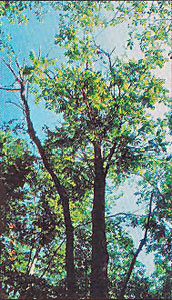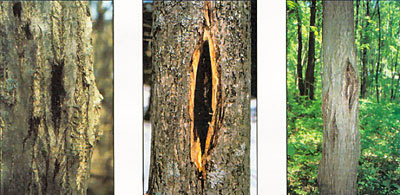TREE TALK
Originally published in Capital on February 1, 2008

Globalization Opens a Pandora’s Box
Exotic Pests Can Wipe Out Native Trees
One of the more disturbing trends in recent years in regards to the health of our forests has been the proliferation of exotic diseases and insects. The increasing globalization of the economy has in a sense opened up Pandora's Box. Now, most of the things Americans buy are manufactured overseas and arrive in shipping containers on pallets from the various locations. Each container potentially carries the next great pest that could wipe out a native tree or other plant. Or, it could be on nursery stock grown for the ornamental trade.
From Dutch elm disease to Chestnut blight to the most recent scourge, the Emerald ash borer, our trees are taking a hit. And it's not just the big trees associated with timber either; the Flowering Dogwood has been under siege for many years from the Dogwood anthracnose. In many areas of the eastern forest, and notably around central Maryland, naturally growing dogwoods are harder and harder, if not impossible to find.
One of the more obscure victims in this silent war is the Butternut or white walnut. Butternut, Juglans cinerea, is a rapidly growing medium-sized tree that is a first cousin to the Black Walnut, Juglans nigra. Butternut, so named because of the very tasty nuts that are sweet and oily, grows over much of the eastern United States. Its original range is not exactly known since it was so widely planted by settlers.
Butternuts start producing seeds at 20 years of age and produce good crops every two to three years. As one might expect from such a prolific mast producer, the Butternut is an important wildlife tree. It is found in regenerating areas that are converting to forest from open fields. The wood is quite prized, having a golden color that polishes to satin sheen, and it is easily worked making it popular for cabinets, instruments and other crafts. Since it never grows to very large sizes, logs large enough to saw lumber from are scarce to begin with. Never a common tree, it is nonetheless an important part of the forest, mostly providing mast for wildlife and nuts for human consumption.
Then in the late 1950's, butternuts started dying. At first it was thought to be a natural phenomenon, after all trees do die and butternut is not a long-lived tree, 75 years being the upper range of their life span. But it was noticed that trees of all ages were dying and rapidly too. When trees die from old age it's usually more gradual. Closer investigation revealed what everyone feared: another exotic disease was on the loose. The pathogen was identified in a study done in Wisconsin as Sirococcus clavigignenti-juglandacearum.
 |
||
| Black sooty appearance
of cankers on the trunk during the summer. |
Stained wood beneath the bark. | Older cankers on the trunk. |
Butternut Canker, as it is known, starts out by infecting the leaves, buds or twigs through any opening, be it a wound or natural, like a stomata as found on a leaf. The disease spreads and eventually girdles the tree and killing it. Unlike the Chestnut blight, which top kills the tree allowing the stump to continue to sprout for many years, the butternut canker is final and complete. By the mid 1990's, the US Forest Service estimated almost 80% of the species has been wiped out in the Southeast. This is grim news indeed. However, there are reports of resistant specimens growing among infected and therefore dying trees. So, there is some hope. The question is: What is the next tree to be threatened? We probably need to only wait and see what the next shipping container brings us.
Learn more about the Butternut at the Virginia Tech Tree ID website:http://www.cnr.vt.edu/dendro/dendrology/syllabus/factsheet.cfm?ID=31
Questions and comments can be directed to
ForestGreenway@comcast.net
Bud Reaves writes Tree Talk for the Anne Arundel County Forest Conservancy
District Board.
Photo of crown dieback due to infection by the fungus and cankers on tree trunk, courtesy of USDA - Forest Service.
Additional Forestry-Related Links
Champion Trees of Anne Arundel County
Big Tree Champions of Maryland
Native Plants for Anne Arundel County
Planting and Care of Your Trees
TREE-MENDOUS MARYLAND
Invasive Species